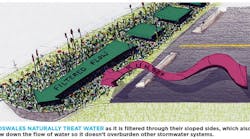April showers lead to May flowers, but heavy rains can easily overwhelm your city’s sewer system. In order to manage stormwater volume, many municipalities require commercial property owners to implement strategies that catch or delay the flow of rainwater. Bioswales, shallow trenches filled with vegetation, are a permanent way to filter and clean runoff. Learn how to create and maintain these passive landscape features.
Natural Stormwater Management
Stormwater runoff is a leading source of water pollution. As rainwater runs across impervious surfaces, a number of contaminants are swept into the stormwater, which is discharged into nearby waterways. Not only can these pollutants be toxic to animal and plant life, but the fast-moving water volume contributes to streambank and channel erosion.
“As humans develop the world, we create impervious surfaces. This changes how water acts when it hits the ground. Instead of soaking into the soil, the water carries sediment, chemicals and auto fluids like oil and antifreeze directly into the discharge system,” says Bob Grover, President of Pacific Landscape Management and member of the National Association of Landscape Professionals (NALP).
Under the umbrella of green infrastructure, bioswales are a cost-effective way to manage inundation from wet weather events. These conveyance systems encourage surface drainage and naturally treat stormwater before it reaches lakes and rivers. The sloped sides of a bioswale also slow down the flow of the water, reducing the burden on a city’s storm drains during heavy rains.
“Unlike concrete, which delivers all of the rainwater at once, bioswales send water in batches,” explains Michelle Slovensky, Energy Program Manager for NREL. “By reducing peak storm flow, the velocity of textured materials during the conveyance process is lessened.”
The Effectiveness of Green Infrastructure
Bioswales are also filled with dense vegetation, which uses natural filtration to remove dirt and pollutants. By mimicking an ecosystem, bioswales treat water before it reaches the ground table or drainage system.
“Plants biologically digest pollutants by disaggregating chemical compounds. Bioswales can mitigate everything from phosphates and nitrates to sulfates and magnesium,” Slovensky notes.
Specifically designed to handle large rain events, bioswales allow the water to percolate at a slower rate than the rainfall. Water is absorbed or conveyed within 48 hours, meaning there’s no standing water that can become a breeding ground for mosquitos, says Slovensky. Bioswales can also be linked to a detention or retention pond so there’s another opportunity to catch overflow.
Bioswales are often confused with rain gardens, which function similarly but are intended for light to modest rainfall. A rain garden is a small depression that is typically placed adjacent to turf grass patches or next to a building’s foundation and sidewalks. They can include plants and rocky materials to encourage infiltration.
“A rain garden is often created by disconnecting a building’s downspouts and directing the rainwater into a vegetative basin next to the exterior,” Grover explains.
Rain gardens are a complementary strategy often used in conjunction with bioswales. At the New Roots Community Farm in the Bronx, a bioswale and rain garden are located along the contours of the site’s 8% slope. The bioswale has a perforated pipe buried 1.5 feet into the ground that slowly directs excess water toward the rain garden. The NREL campus in Golden, CO, also features a network of rain gardens and bioswales, which helped the agency earn SITES certification.
How to Create a Bioswale
Bioswales are typically easy to add to existing properties. Before you dig, gather data on annual rain events and average rainfall volume. Note where sheet flow is the most forceful during storms on your property, Slovensky recommends. Your landscape contractor may use a flow meter to measure water velocity, which allows them to accurately model the appropriate size and depth for the bioswale.
Unlike a pond, which is meant to continuously hold water, bioswales have a linear shape. Gently sloping sides along the trench ensure gravity propels water into the basin. The slight grade also slows down the water’s velocity to minimize erosion.
“Bioswales aren’t just a dirt impression, otherwise they would erode quickly,” explains Slovensky. “To keep sediment from washing away, a substrate of permeable gravel, or riprap, is often used with layers of compost.”
The root systems of plants hold the layers together and encourage infiltration. Native species fare best in bioswales and need to tolerate frequent downpours and dry stretches alike.
“Plants should match the hydrology produced by your region’s weather patterns,” says Slovensky. “Avoid turf grass, which has a shallow root system, as well as high maintenance plants that need fertilization.”
Bioswales should also feature a matrix of grasses that replicate the plant density and variety found in naturalistic settings, Slovensky stresses. Diverse plants are less vulnerable to disease and pests. They also don’t need to be fertilized because the rainwater delivers a constant supply of nutrients, she adds.
Newly created bioswales need an irrigation component so plants have time and nutrients to become established, Grover notes. Depending on your climate zone, a permanent irrigation system may be required to support plants during drought periods.
Bioswales are often placed next to impervious surfaces, such as parking lots or large patios, where a barrier is needed to slow the path of water. Costs are dependent on the size of the bioswale and whether earth movers are needed to break through compact or rocky soils. This can average $58 per linear foot or $20-30 per square foot, according to the Challenge for Sustainability, a private sector initiative in Boston.
Tend to Maintenance
Manage bioswales like any other landscaping. Otherwise they will grow into an unsightly patch of weeds that does little to intercept stormwater.
“Because you are incubating a wetland-like environment, bioswales require upkeep,” notes Slovensky. “For example, you may need to reseed bald spots where grasses didn’t survive or remove noxious plants by hand. You should also monitor for erosion. If the water is ponding, there’s a problem with the slope.”
Native plants can face competition from invasive species, says Grover. In Oregon, for example, blackberries are a noxious weed that flourishes in riparian areas, which bioswales simulate. It is best to monitor for weeds before they choke out native vegetation.
Overgrown bioswales are not only an eyesore, but their ability to handle rain events is severely compromised. Even properly maintained bioswales will experience sediment buildup over time. Particularly if they have been in use for 10-15 years, older bioswales may need to be dredged with an excavator and replanted, says Grover.
Keep in mind that your city may have “out of compliance” fines, he adds. Some inspectors are proactive about flagging unkempt bioswales, although most will only take a peek if you have applied for a building permit. But the risk of having to completely renovate a bioswale can be avoided with routine maintenance.
“Integrate the bioswale into a prominent portion of your landscape, such as in the middle of a parking lot,” recommends Grover. “If it’s in a noticeable location, it will stay functional because you want it to look good.”
Jennie Morton is a contributing editor for BUILDINGS.


